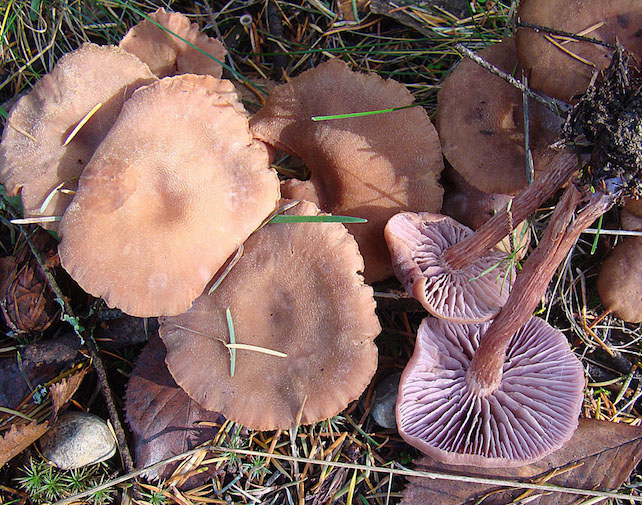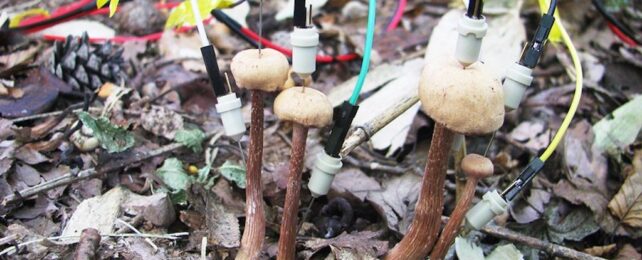A forest often echoes with the sounds of its inhabitants, especially after rainfall. Birds coo and caw, insects chirp and buzz, frogs blip and bellow.
But not all forest conversations are audible – nor do they all include animals.
In a new study, scientists in Japan found intriguing hints that rain may prompt some fungi to communicate using underground electrical signals.
The researchers focused on small, tan mushrooms known as bicoloured deceivers (Laccaria bicolor), which they found growing on the floor of a secondary mixed forest at the Kawatabi Field Science Center of Tohoku University in Japan.
L. bicolor is an ectomycorrhizal fungus that forms symbiotic relationships with certain plants, including many large trees like oaks and pines. It boosts their supply of water and nutrients in exchange for carbohydrates.
Previous research even suggests L. bicolor may help some trees indirectly feed on animals, luring insect relatives called springtails and killing them possibly with a toxin, sharing the animal's nitrogen with their host trees.
While some mycorrhizal fungi penetrate the cell walls of their host plants, ectomycorrhizal fungi like L. bicolor instead build subterranean "sheaths" around the exterior of a tree's roots.
These sheaths are made of hyphae, the rootlike filaments that fuel the growth of a fungus. When the hyphae of mycorrhizal fungi link underground they form interconnected systems known as mycorrhizal networks. Such underground networks have been proposed as acting as a kind of "wood-wide web," where entire forests communicate via chemical signals down tree roots and mycorrhizal fungi.
While mycorrhizal networks are real, there is too little evidence to know if they reach the scale and complexity often attributed to wood-wide webs. Many popular accounts of this phenomenon are overstated, some scientists say.
Nonetheless, this study adds to a growing body of research that delves into the details of these relationships, revealing fascinating details about how they work.
Previous studies have shown fungi produce variations in electrical potentials seemingly in response to changes in their environment, with clues suggesting these signals serve as a form of communication.
A 2022 study, for example, found patterns of nerve-like electrical activity in some fungi that seem comparable to the structure of human speech. The study identified up to 50 different "words," or groups of spikes in electrical activity, generated by fungal networks.
Earlier research has also found that plants can send secret electrical signals underground, possibly even without help from mycorrhizal fungi.
While spikes of electric potential have been seen in fungi before, sometimes in response to water or other stimuli, most studies have focused on limited types of fungi grown on artificial media or collected from the field under laboratory conditions, the authors of the new study note.
In the new study, researchers attached electrodes to a cluster of six L. bicolor mushrooms they found growing on the side of a forest trail.
The mushrooms were located near a jolcham oak (Quercus serrata) and a loose-flower hornbeam (Carpinus laxiflora), both potential symbiotic tree species for L. bicolor.

The researchers monitored the mushrooms' electrical potential, measured in millivolts (mV), for about two days in late September and early October 2021. The study site was initially sunny and dry, having received little rain in the previous twelve days, they report.
That changed on October 1, however, when Typhoon Mindulle brought 32 millimeters of rain. One to two hours after the rainfall, the mushrooms began showing new signs of activity.
"In the beginning, the mushrooms exhibited less electrical potential, and we boiled this down to the lack of precipitation," says microbial ecologist Yu Fukasawa of Tohoku University. "However, the electrical potential began to fluctuate after raining, sometimes going over 100 mV."
This fluctuation correlated with changes in both precipitation and temperature, according to Fukusawa and his colleagues, whose analysis suggests the electrical signal after rainfall showed evidence of signal transport among mushrooms.
This signal transport was especially strong between mushrooms located closer to one another on the forest floor, the researchers report, and demonstrated directionality.
While the new study is far from definitive, it adds another intriguing piece to the puzzle of what role fungi play in the often-overlooked ecosystems hidden underneath forest floors.
"Our results confirm the need for further studies on fungal electrical potentials under a true ecological context," Fukasawa says.
The study was published in Fungal Ecology.
